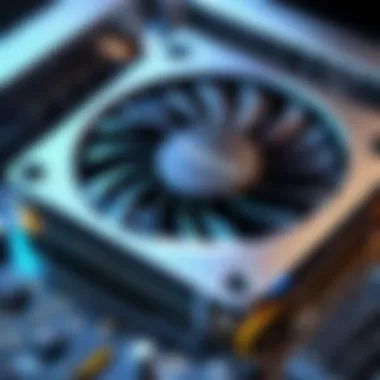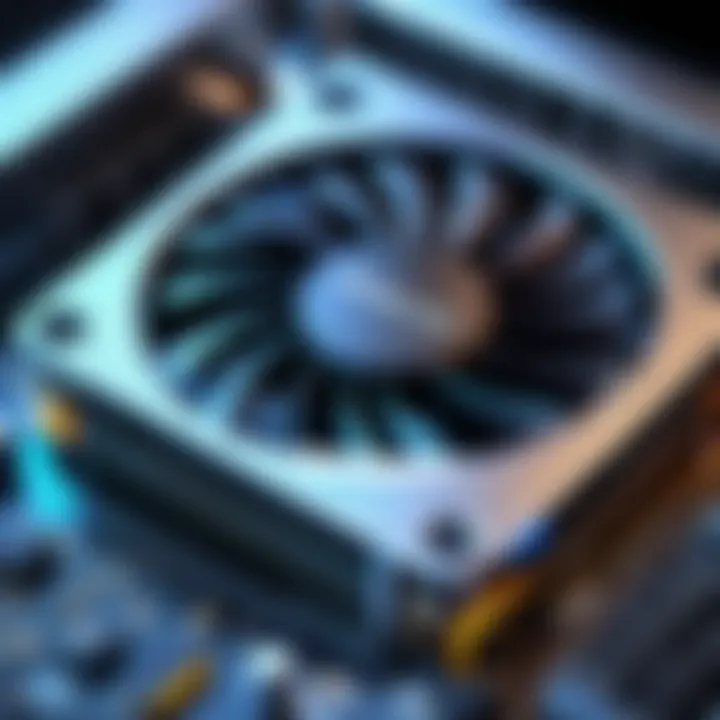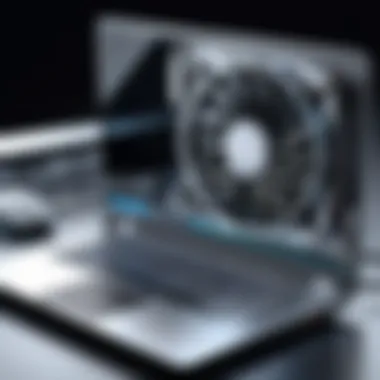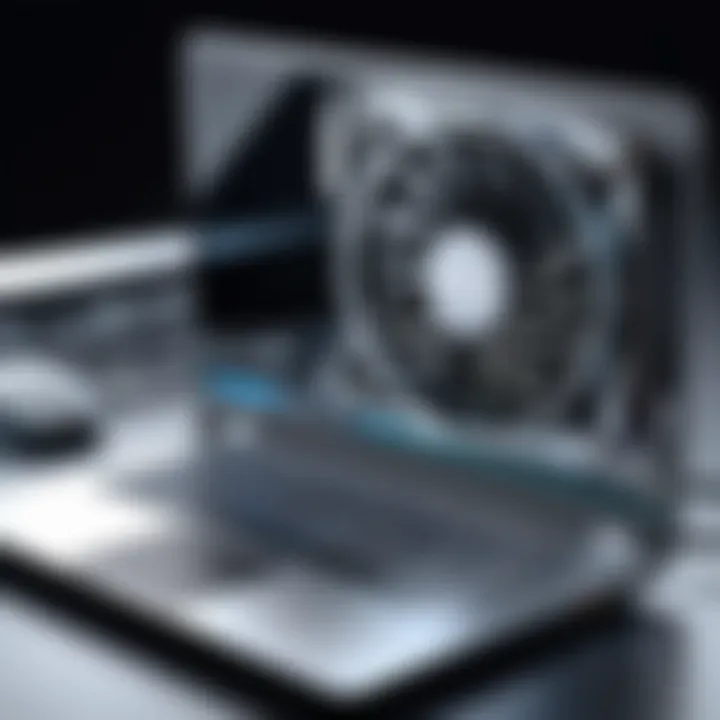Effective Strategies for Laptop Temperature Management


Intro
In today’s fast-paced digital age, laptops have become integral to both our personal and professional lives. With their growing importance, there's an increasing need to grasp how temperature management plays a crucial role in maintaining functionality and longevity. Underestimating the significance of keeping a laptop cool can turn your beloved device into a slow, glitchy mess or worse, a broken piece of technology.
Laptop overheating can lead to a plethora of issues, affecting performance, battery life, and even the internal hardware. It's essential to understand the reasons behind these heat spikes, the signs that indicate overheating, and ways to effectively manage it. This guide aims to arm you with knowledge and practical strategies that not only help mitigate risks but also enhance your overall computing experience.
We're going to cut through the technical jargon and lay bare the concept of laptop temperature management in a straightforward manner. From identifying the common culprits of heat accumulation to exploring effective cooling methods, you will gain insights that help you make informed decisions to protect your device.
Importance of Temperature Management
The significance of managing laptop temperatures cannot be understated. High temperatures can warp internal components and lead to permanent damage. In some cases, excessive heat could even lead to total hardware failure. Thus, understanding how to keep your laptop at optimal operating temperature is vital not just for performance, but also for extending the life of the machine itself.
Moreover, modern laptops operate under various loads depending on tasks like gaming, video editing, or simple browsing. Each exertion places different demands on the device, leading to varying temperature levels. The necessity for effective cooling strategies becomes apparent, particularly during those heavy use periods.
Your attention to laptop temperature management could mean the difference between a device that runs like a well-oiled machine and one that’s held back by heat-related issues.
Preamble to Laptop Temperature Management
Laptop temperature management is an essential aspect of maintaining your device’s health and performance. As technology advances and software demands increase, understanding how to manage the heat generated by laptops becomes increasingly significant. Proper temperature management not only enhances performance but also prevents the wear and tear that can lead to costly repairs or even total failure.
The Importance of Monitoring Temperature
Monitoring the temperature of your laptop can be likened to checking the vitals of a well-oiled machine. Just as a car engine requires optimal temperatures for efficiency, laptops need to stay within a certain thermal range to function effectively. High temperatures can lead to throttling, where the laptop automatically reduces its performance to cool down, affecting everything from gaming to video editing.
Moreover, regular monitoring helps you catch potential issues before they escalate. Ignoring temperature signals can end up costing you dearly—both in terms of your device’s lifespan and your wallet. By being proactive about temperature management, you not only protect your investment but also ensure a smoother and faster computing experience.
Common Misconceptions about Laptop Heat
It's easy to fall for misconceptions about why laptops overheat or how to best alleviate the problem. For instance, many people believe that a laptop should be left on all the time, assuming it's designed to handle constant use. However, this can be a recipe for increased heat retention. Here are some prevalent myths:
- More Fans Mean Less Heat: Many assume that adding more fans will always solve overheating. Yet, if airflow is obstructed, even the best fans can't prevent overheating.
- Overheating is Only a Problem for Gamers: This misconception suggests that only high-performance tasks cause heat issues. In reality, any intensive task can raise temperatures, whether it be graphic design, spreadsheets, or running multiple applications simultaneously.
Keeping your laptop cool requires more than just powerful hardware; it also needs a good understanding of its cooling system and environment.
Understanding Laptop Overheating
Understanding laptop overheating is pivotal in ensuring the optimal functioning and longevity of a computer. While laptops are designed to operate within a certain temperature range, various factors can cause them to exceed this range, resulting in overheating. When users grasp the significance of overheating, they can take proactive measures to maintain their devices and avoid performance degradation, or worse, hardware failure.
Overheating isn't just about a laptop feeling warm to the touch; it can have far-reaching effects on the internal components and how effectively the machine runs. From the processor to the graphics card, every part contributes to heat generation. Knowing what constitutes overheating helps users spot potential issues before they turn into serious problems.
What Constitutes Overheating?
Overheating in laptops typically occurs when internal temperatures rise above the manufacturer's specified limits, usually around 90 to 100 degrees Celsius for most parts. If operating temperatures consistently exceed this threshold, there can be serious consequences. The following points highlight key indicators of overheating:
- High Internal Temperatures: As temperatures rise, components may operate abnormally or become damaged.
- Thermal Throttling: Many modern laptops reduce the speed of the CPU and GPU to lower temperatures, impacting performance.
- Frequent Shutdowns or Restarts: Safety measures in most laptops lead to automatic shutdowns to protect hardware from damage due to excessive heat.
Common Causes of High Temperatures
Several factors can contribute to high temperatures in laptops. Recognizing these can help users implement effective cooling strategies:
- Dust Buildup: Over time, dust can accumulate in vents and fans, obstructing airflow. Cleaning the internal components can significantly improve heat dissipation.
- Poor Ventilation: Using laptops on soft surfaces like blankets or beds prevents adequate airflow, leading to overheating.
- High Resource Usage: Running resource-intensive applications, like gaming or video editing software, generates substantial heat. Monitoring running tasks can help manage this issue.
- Aging Hardware: As components age, their efficiency can diminish, leading to increased heat production.
Effects on Performance and Longevity
The impact of overheating can be severe, resulting in both immediate performance issues and long-term damage to a laptop.
- Immediate Performance Issues: When a laptop overheats, performance can suffer. This is especially true during resource-heavy operations, where throttling slows down processing speeds.
- Reduced Lifespan: Excessive heat can shorten the lifespan of components, particularly the CPU and GPU. Thermal stress can degrade their materials over time, resulting in failures that require costly repairs or replacements.
"A laptop’s life is often as good as its cooling solution. When heat gets out of hand, everything else follows suit.”
- Data Loss Risks: In extreme cases, overheating might lead to sudden system shutdowns. If a laptop becomes unresponsive, there's a risk of working on unsaved documents or losing important files.
In summary, recognizing and understanding laptop overheating is crucial for any user hoping to protect their investment in portable technology. It allows for more informed decisions regarding maintenance, software usage, and physical environment, ultimately enhancing performance and ensuring longevity.
How to Check Laptop Temperature
Monitoring your laptop's temperature is crucial. Why? Because it provides insights into how well your device is handling tasks and whether it's at risk of overheating. Knowing the temperature can help prevent issues like performance drops or even hardware failures. It's not just about keeping your laptop running; it's about prolonging its life and ensuring your data remains safe.
When laptops get too hot, they can throttle performance to cool down, which is frustrating, especially during intensive tasks like gaming or video editing. This section will detail how to effectively check the temperature of your laptop, so you can stay ahead of potential problems.
Using Built-in Monitoring Tools


Many laptops come equipped with built-in monitoring tools that keep track of various metrics, including temperature. These tools can often be accessed through the BIOS or operating system settings.
To use these tools, restart your laptop and enter the BIOS menu, usually by pressing F2 or Delete during boot-up. In there, you can find hardware monitoring features that show the CPU and temperature readings. This method is straightforward, but it may not provide real-time data while you're doing tasks.
Using built-in tools has its upsides. They are often reliable since they come directly from the hardware manufacturer. However, for most users, real-time monitoring while the operating system is running is preferred.
External Software Options
While built-in tools are great, you might want even more control and detailed analysis. This is where external software options come in. These programs can provide real-time temperature readings, logs, and even alerts if temperatures reach dangerous levels.
Overview of Popular Tools
There are several applications popular among laptop users for monitoring temperatures, like Core Temp, HWMonitor, and SpeedFan. Each of these has its unique flair. For instance, Core Temp provides a simple user interface and pretty accurate readings of your CPU’s temperature. It’s lightweight and doesn’t smother your system with background processes.
The main charm of these tools is their ability to deliver insights into various components of your laptop. Users can often view temperature data for the GPU, CPU, and even hard drives. But with this plethora of information comes the challenge of interpreting the data accurately.
One downside to consider is that external applications can occasionally conflict with other software or require administrative privileges for deeper access, which might put off some less tech-savvy users.
Installation and Usage Tips
When choosing an external software tool, ease of installation is key. Most of these programs come with an installer that guides you through the process, making it straightforward for anyone with a little tech know-how. However, be careful of where you download these tools from. Stick to official websites or reputable sources.
Once installed, familiarize yourself with the interface. Most tools provide options to set alerts at certain temperature thresholds. This feature is particularly helpful, as it can send notifications straight to your desktop when things heat up.
It's wise to configure these alerts so that you can address problems before they escalate. Be aware, though, that too many alerts can lead to notification fatigue; thus, balance is essential.
Using both internal and external monitoring tools can provide a thorough understanding of your laptop's health. This dual approach ensures you catch overheating before it leads to more severe issues.
In summary, keeping an eye on laptop temperatures using built-in tools and external software equips you with vital knowledge to maintain optimal performance. This not only preserves your device’s lifespan but also enhances your experience as a user.
Recognizing Signs of Overheating
Understanding how to recognize signs of overheating in laptops is crucial for maintaining their performance and extending their lifespan. Often, users may not be fully aware of how heat can affect their device, leading to significant issues down the line. Early detection of heat problems allows for timely actions to mitigate risks.
Physical Indicators of Heat Issues
Several physical indicators can point to heat problems in a laptop. If the laptop feels unusually hot when in use, that’s often the first red flag. Specifically, areas around the fan exhaust and the bottom of the device may become excessively warm to the touch. Users may notice that the laptop's material might even become soft if it’s a plastic model, which is an alarming sign of heat stress.
Another noticeable sign is the sound of the fan – if it’s running louder or more frantically than usual, it might be working overtime to try and cool down the components inside. Dashboard lights may also act erratically, with blinking signals indicating warnings that something might be wrong. Regular visual checks of these indicators can save a laptop from drastic damage.
Performance-related Symptoms
When laptops are on the brink of overheating, performance can take a hit, causing a cascade of additional problems. Users may find themselves facing various issues that can be categorized into two main symptoms: slow performance and frequent crashes.
Slow Performance
One of the key aspects of slow performance in an overheating laptop is the throttling of CPU speeds. Modern processors, such as Intel's Core i7 or AMD's Ryzen series, come with thermal management features that slow down performance to reduce heat production. If your laptop seems sluggish during tasks that it normally handles well, it could be a signal that the system is genuinely trying to protect itself from overheating.
This inconsistency can be incredibly frustrating. A laptop that once seemed lightning-fast might now lag, making it difficult to complete even basic tasks like browsing or editing documents. Additionally, prolonged periods of slow performance often result in users being unable to run multiple applications simultaneously, leading them to monitor each opened program more closely, which in turn increases fatigue.
Frequent Crashes
Frequent crashes occur when a laptop’s thermal limits are exceeded. When the internal temperature becomes too high for too long, components can misbehave, leading to system instability. The key characteristic of this symptom is the unpredictable nature of the crashes—often happening at random intervals without clear warning.
This is particularly concerning because users may lose unsaved work or interrupt important presentations. The unique feature of frequent crashes ties directly to the overheating issue, as they signal a cry for help from the laptop’s internal sensors, asking for immediate relief. Therefore, understanding this symptom is essential; recognizing it quickly offers a chance to resolve any underlying overheating issue before it turns catastrophic.
"Regular checks of your laptop's performance related symptoms can contribute significantly to its health, thus ensuring efficiency and longevity."
Effective Cooling Methods
Managing laptop temperature isn't just a nicety; it's a necessity. When temps rise, the potential for performance dips or hardware damage looms large. Thus, adopting effective cooling methods ensures your machine's longevity and keeps it running like a well-oiled machine. The right cooling solutions can dramatically influence how well your laptop serves your needs, making this topic worth the dive.
Internal Hardware Solutions
Thermal Paste Application
Thermal paste acts as a thermal conductor between the CPU or GPU and the heat sink. Applying it properly can lead to a significant reduction in heat transfer resistance. This characteristic makes thermal paste a crucial player in keeping laptop temperatures at bay.
One of the main benefits of thermal paste is its ability to fill the microscopic gaps between surfaces. If it's done right, you’ll notice a click in performance—such as less throttling during heavy tasks or gaming. It’s a popular choice among tech enthusiasts because it’s relatively easy to do and can yield gratifying results.
While it requires some know-how, the unique feature that stands out is its low cost compared to other cooling solutions. However, improper application can lead to issues such as reduced performance or overheating—less than ideal outcomes, to say the least. Thus, it's vital to apply a thin, even layer and to research the specific type suitable for your processor. Here’s where you'll want to tread carefully: maintain cleanliness during application to avoid contamination.


Cleaning Internal Components
Over time, dust and debris can build up inside your laptop, acting like a sponge that soaks up heat instead of allowing it to dissipate. This is where cleaning your internal components steps in as an unsung hero. Keeping the fans, vents, and heat sink free from dust can dramatically improve air circulation. This characteristic highlights its importance as a highly beneficial maintenance routine.
Cleaning often goes hand in hand with performance optimization. If you neglect this task, you might notice your laptop feeling warmer or responding sluggishly. By addressing this simple task, you can breathe new life into your laptop's cooling capability.
While cleaning isn't excessively complicated, it does require some caution. Improper disassembly or overzealous cleaning could risk damaging your components, so taking it slow is advisable. If you’re unsure, consider consulting online guides or tech forums for clearer instructions. It's a small effort for a big payoff—your laptop will thank you for it.
External Cooling Solutions
Laptop Cooling Pads
Laptop cooling pads have become a go-to solution for users looking to keep their devices cool, especially during heavy usage periods. These pads are designed to increase airflow around the laptop, effectively dissipating heat much better than the laptop alone can manage. One of the most appealing aspects is their simplicity; just place your laptop on it, and it gets to work.
A standout feature of cooling pads is their availability in various forms and designs, which can cater to a variety of user preferences and laptop sizes. Some even come equipped with fans that provide an active cooling experience, being particularly popular among gamers and heavy multitaskers. However, while they are generally effective, there's a trade-off. They often require additional power and take up some space, which might not be practical for everyone.
Cooling Stands
Cooling stands take the concept of enhanced airflow a step further. In addition to providing a surface for the laptop, these stands allow for better ergonomic positioning. This is particularly relevant for those spending hours at a time on their devices. Like cooling pads, they promote airflow, but they often come with adjustable heights and angles. One key characteristic is the versatility in design—some models even have built-in fans for additional cooling.
These stands are beneficial in that they not only combat heat but also improve your posture. However, they might require some consideration regarding portability. If you're often on the go, a cooling stand might add a bit of bulk to your carrying load. Yet, for in-home or office use, the comfort combined with temperature management can be a winning combination.
Ultimately, incorporating a blend of internal and external cooling methods into your laptop care routine can ensure not just optimal performance but also a lengthy lifespan for your device.
Best Practices for Temperature Control
Effective temperature control is not just a nice-to-have in laptop maintenance; it’s a necessity for keeping devices running smoothly and extending their lifespan. Over time, dust accumulation, heavy software demands, and careless usage can all contribute to elevated temperatures. By adopting best practices for temperature control, you create a buffer against overheating while enhancing the device's efficiency.
Regular Maintenance Routines
Routine maintenance is the backbone of ensuring your laptop remains cool and efficiently operational. Regular check-ups can prevent minor issues from snowballing into bigger problems. Here’s a handy checklist to keep your laptop in tip-top shape:
- Cleaning the Vents and Fans: Dust and debris can block airflow, making it harder for your laptop to cool down. Every month or so, consider giving the vents a thorough cleaning. This can be done with compressed air to blow out the dust effectively.
- Reapplying Thermal Paste: If your laptop is older, the thermal paste—that conductive medium between the CPU or GPU and the heat sink—may have dried out. Reapplying it can significantly improve cooling efficiency.
- Updating Drivers and Firmware: Keeping your system software up-to-date can help optimize performance. Sometimes, manufacturers release updates that enhance power management, which in turn affects heat generation.
"Regular maintenance isn’t just a formality; it’s an investment in your laptop’s future."
Avoiding Resource-Intensive Tasks
Certain tasks demand a hefty amount of processing power, leading to increased thermal output. Awareness of these tasks can make a marked difference in your laptop's temperature levels. Here are tips to minimize resource strain on your device:
- Limit Background Processes: Check for any unnecessary applications running in the background. These can take up CPU cycles and generate extra heat without you realizing it. Tools like Task Manager on Windows or Activity Monitor on Mac can be useful for this.
- Be Mindful of Gaming and Heavy Software: While gaming or working with graphic design software, the hardware is pushed to its limits. Try to elevate ventilation during these activities. You might also consider using an external cooling pad to draw heat away from the laptop.
- Plan Heavy Tasks During Cool Hours: If you're performing resource-heavy work, try scheduling it for cooler parts of the day. Laptops naturally get warmer in hot weather, so timing your tasks can help mitigate the risk of overheating.
By embracing these best practices, users can take significant strides toward managing laptop temperatures. The cumulative effect of regular maintenance routines and mindful task management can dramatically maintain performance and longevity of a device.
Using BIOS Settings for Temperature Management
When it comes to managing laptop temperature, BIOS settings hold more importance than many users realize. The BIOS (Basic Input/Output System) acts as a bridge between the operating system and the hardware of the laptop. Making adjustments in BIOS can help regulate temperature, essentially functioning as an intrusive yet highly effective element in maintaining optimal performance.
Accessing BIOS Menu
Accessing the BIOS can seem daunting, especially for those not well-versed in computer systems. To enter the BIOS menu, typically one would restart their laptop and press a specific key during the boot process. Common keys include F2, F10, or Delete — this varies by manufacturer. For instance, if you own an Asus laptop, hitting F2 would do the trick. On HP laptops, the key might be Esc or F10. It's like entering a secret lair where you can control various hardware aspects that affect temperature management.
Once inside the BIOS, you might find various sections. Look for options related to thermal management or hardware settings. The layout can differ between models, so don’t be surprised if it feels like searching for a needle in a haystack. Remember to navigate carefully to avoid any unintended changes that could affect your laptop’s function.
Adjusting Fan Speeds
After you locate the right section in the BIOS, adjusting the fan speeds can bring significant cooling benefits. Many laptops automatically manage fan speeds based on temperature readings, but sometimes this automatic setting might not suffice. Increasing the fan speed can provide a quick fix to overheating issues, maintaining a lower temperature while performing intensive tasks or gaming.
You might see options like "Standard", "Turbo", or "Silent" modes. Choosing Turbo mode enables maximum airflow, ideal for high-demand situations. However, cranking up the fans can also lead to increased noise levels, which may not be ideal in quieter environments. Many users opt for a middle ground, selecting a balanced fan speed that efficiently cools the system without generating excessive noise.
"Users can't control the weather, but they can certainly control their laptop’s temperature with a few keystrokes!"
By taking these proactive measures, you can ensure that your investment remains secure and functions optimally for years to come.
The Role of Ventilation in Cooling
When we think of laptop maintenance, cooling systems often slip to the back of our minds. However, the role of ventilation is vital in maintaining a laptop's operating temperature. Proper airflow can be the difference between a device that runs smoothly and one bogged down by overheating issues. This section sheds light on why ventilation matters and how it ties into the broader theme of temperature management.
Importance of Proper Airflow
Airflow through a laptop is as crucial as blood flow in a living organism. A laptop, while compact, generates a significant amount of heat during operation. Without enough air circulation, that heat can build up, leading to decreased performance and, in severe cases, hardware damage. The primary purpose of ventilation in laptops is to allow hot air to escape while ensuring that cooler air is drawn in.


To illustrate, consider this: imagine your laptop as a high-performance race car. Just as a race car needs air to keep its engine running at optimal temperatures, laptops rely on adequate airflow to maintain their performance.
- Heat Dissipation: Ensuring that hot air can quickly escape helps maintain lower internal temperatures.
- Component Longevity: Many electronic components have a specific range of temperatures they can safely operate within. If these components constantly run hot, their lifespan could be significantly shortened.
- Performance Consistency: Laptops may throttle performance to prevent overheating, which can result in lagging during tasks. Proper ventilation helps avoid this throttling.
Best Practices for Laptop Placement
Where you place your laptop can make all the difference when it comes to temperature management. Here are a few best practices to consider:
- Flat, Hard Surfaces: Use your laptop on flat, hard surfaces. Soft surfaces like beds or sofas can block vents, disrupting airflow and trapping heat.
- Avoid Direct Sunlight: Placing your laptop in direct sunlight can raise temperatures significantly. It's best to find shaded areas.
- Keep it Elevated: Consider using laptop stands to elevate your device. This way, you can promote better airflow from underneath, keeping the underside cooler.
- Space Around the Device: When using your laptop, ensure that there’s enough space around it—at least a few inches on all sides. This prevents heat from becoming trapped.
Taking these precautions ensures that your laptop remains cool, operates efficiently, and lasts longer. Remember, if your device is overheating, sometimes the most straightforward solution could be just a slight adjustment in where you place it.
"Where you put your laptop can speak volumes about how long it will serve you and how well it performs.
By prioritizing proper airflow and mindful placement, you’ll set the stage for better thermal management.
Impact of Software on Laptop Temperatures
In this digitally-driven world, software plays a pivotal role in how our laptops perform, especially regarding temperature management. The right software can make a significant difference in maintaining optimal operating conditions and preventing overheating. Understanding how software impacts laptop temperatures is essential for users who want to prolong the life of their devices and enhance performance.
When it comes to temperature control, the relationship between software and hardware cannot be overstated. Software not only manages system processes but also interacts directly with the hardware components that generate heat. Many users might not realize that the applications they run daily can either exacerbate or alleviate heating issues.
Resource Management through Software
Effective resource management is key to keeping laptop temperatures at bay. Programs that demand high processing power can turn your laptop into a sauna faster than you can say "thermal throttling." Here are a few important aspects to consider:
- Task Management: Keeping an eye on resource-hungry applications is crucial. Programs like video editing software or gaming clients can contribute to elevated temperatures. Occasionally checking the Task Manager or Activity Monitor to kill unnecessary processes can be a game changer.
- Background Services: Software that runs unnoticed in the background can drain resources and produce excess heat. Periodically reviewing startup programs and disabling those that are not essential can help mitigate this issue.
- Scheduled Tasks: Setting certain resource-intensive tasks, like backups or virus scans, to occur during off-peak hours can reduce the load on your laptop during heavily used times, optimizing heat management.
Adapting your behavior regarding software usage can have a noticeable impact on your laptop's thermal performance.
Thermal Management Applications
Thermal management applications are yet another layer of defense against overheating. These tools help monitor and control temperatures by providing insights into system performance. Here are some notable functionalities they offer:
- Temperature Monitoring: Many applications can display real-time temperature readouts for various components, such as the CPU and GPU. This visibility allows users to adjust their usage habits accordingly—if your CPU is nearing the danger zone, it’s time to take a breather.
- Fan Control: Some software offers advanced features that allow users to adjust fan speeds manually. Increasing a fan's RPM can enhance airflow and cooling, especially during high-load scenarios.
- Power Plans and Throttling: Numerous thermal management tools enable users to tweak power settings, promoting energy-saving modes that limit performance during light tasks. This not only reduces heat generation but also contributes to battery longevity.
Utilizing thermal management applications is a proactive approach to safeguarding against overheating. By leveraging these tools, users can ensure their laptops remain cool under even the most demanding conditions.
Takeaway: Understanding the impact of software on laptop temperatures empowers users to make informed decisions regarding resource management and the use of thermal applications, ultimately leading to longer device lifespans and smoother performance.
Consulting Professionals for Overheating Issues
When it comes to laptop maintenance, acknowledging when the situation is beyond personal expertise can be a game changer. Consulting professionals for overheating issues not only provides a fresh perspective but also ensures that you’re making informed decisions about the health of your device. Heat-related problems can manifest in various ways, and often, the root causes might not be visible or easily identifiable.
When to Seek Help
It's crucial to know when to reach out to an expert. If your laptop is experiencing frequent shutdowns or performance throttling, these are clear signals. Additionally, if the fan seems overly loud or runs continuously, it might be struggling to cool off the internals effectively. Here are some specific scenarios where you should consider consulting a professional:
- Consistent Overheating: If your laptop continues to run hot even after applying preventive measures, it’s time to seek professional help.
- Physical Damage: Signs like warped casing or melting components are serious red flags.
- Persistent Error Messages: Occasionally, you might see errors from your operating system indicating temperature issues; don’t ignore these.
Overall, early intervention can save you from further complications down the line.\
Choosing a Reliable Technician
Finding the right technician can be a daunting task, especially if you're not familiar with the technical landscape. To ensure your laptop is in capable hands, consider these guidelines for selecting a trustworthy professional:
- Look for Certifications: Technicians who are certified by recognized organizations are more likely to provide quality service. Check for credentials from companies like CompTIA or A+ certification.
- Read Reviews and Testimonials: Websites like Reddit can provide insights into local services that others have found satisfactory or unsatisfactory. Make sure to skim through reviews on multiple platforms.
- Ask About Experience: A technician's experience plays a pivotal role. Don’t hesitate to ask how long they have been dealing with laptop repair, especially regarding cooling solutions.
- Check for Warranty Information: A good technician should offer a warranty on their repairs. This should give you trust in their work quality.
- Get a Quote Beforehand: Transparency in pricing can indicate credibility. A reliable technician should give you an estimate before starting any repairs.
Employing these strategies should offer confidence in your choice of technician. After all, employing someone with experience not only reassures you of the outcome but can also help you better understand the long-term care your laptop might need.
Closure: Ensuring Longevity through Temperature Management
Effective temperature management is central to maintaining a healthy and functional laptop. The importance of this topic cannot be overstated; it directly relates to the device's performance, longevity, and even its overall safety. When a laptop experiences excessive heat, it begins to compromise not only the efficiency of its components but can also cause irreversible damage. Understanding how to manage and mitigate this heat issue can prolong the lifespan of your device significantly.
In this concluding section, it’s critical to highlight several key considerations:
- Regular Monitoring: Keeping an eye on how hot your laptop gets is essential. Using built-in monitoring tools or external software can offer crucial insights that help prevent overheating before it becomes a serious problem.
- Proactive Maintenance: Incorporating routine maintenance, like cleaning dust from vents and updating thermal paste, forms a solid foundation for effective temperature management. It’s always easier to prevent issues than to rectify them after they arise.
- Cooling Options: The utilization of cooling pads and proper ventilation techniques can provide immediate relief from high temperatures, enhancing not just longevity but also user experience.
- Behavioral Modifications: Sometimes, the simplest solutions are the most effective. Avoid running too many resource-intensive applications simultaneously, and ensure your laptop is placed in a well-ventilated area.
- Professional Help: When things seem to go awry and the problem persists, seeking professional assistance is wise. Technicians can offer specialized insights and repairs that may be beyond your existing knowledge.
Ultimately, the careful orchestration of these factors can safeguard your laptop against heat-related failures and bolster its performance. As users entrust more data and tasks into their portable machines, it is essential not to overlook the implications of temperature management. The more informed and proactive one is, the better off their laptop—and by extension, their productivity—will be.
Final Thoughts on Laptop Maintenance
In summary, maintaining a laptop's health isn't merely about fixing issues as they arise. It's about fostering an environment that minimizes potential risks, particularly concerning temperature management.
Each preventive step taken helps avoid frustrating situations that stem from overheating. Here are a few final takeaways:
- Set Reminders: Don’t just wait for summer to give your laptop some TLC. Schedule regular checks to monitor temperatures and dust accumulation.
- Educate Yourself: Being aware of your device's specifications will enable you to understand its limits and avoid stressing it more than necessary.
- Embrace Technology: Make use of the multitude of available resources online such as forums on Reddit or articles from Wikipedia for ongoing education regarding laptop care.
By implementing these strategies, one creates a sustainable relationship with their device, ensuring that it runs smoothly for years to come. After all, a well-maintained laptop can serve you relentlessly, becoming an indispensable ally in both your professional and personal endeavors.







